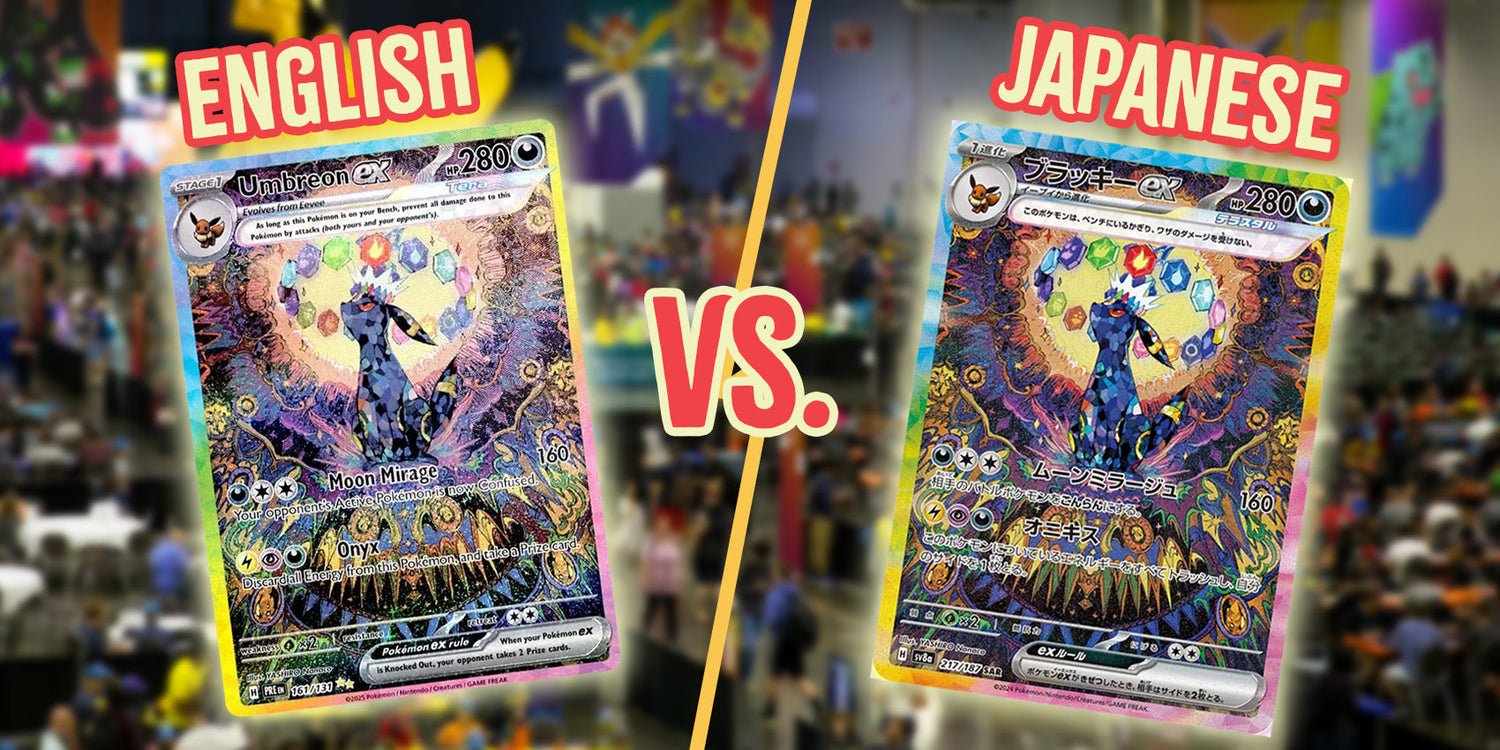
English vs. Japanese Pokémon Cards - What's the difference?
What's the difference?
Every so often, I’ll see a question posted online about the real difference between English and Japanese Pokémon cards. In the past two years or so, these questions have become more common, especially as English card prices continue to skyrocket and collectors find it harder to buy new sets at MSRP. The last six months has been especially brutal for Pokémon fans, as scalpers, price manipulators, and “investors” surged into the hobby, greatly diluting the available stock of popular sets.
Now more than ever, Pokémon TCG fans are seriously weighing the long-term costs of engaging in this hobby, and some are completely abandoning ship altogether. When a card like the Scarlet & Violet Base Set Illustration Rare ‘Drowzee’ (210/198) surges to $80 despite its high population and easy pull rates, one must question the point of it all. The Drowzee card has since halved in price as of March 22, 2025, but this is still far higher than its true value, which is probably closer to $6 or $7. Whether you’re a new collector or if you’ve been around for a while, the cost to engage with this hobby is no longer sustainable.

However, even as some collectors ditch the hobby altogether or refocus their efforts on older sets with less attention, some collectors (myself included) have switched to Japanese Pokémon cards. That same Drowzee card in Japanese peaked at only $24 and has since fallen. Price manipulation still happens with Japanese cards, and especially from American sellers on Ebay or Mercari, but it’s significantly harder to do for a few distinct reasons.
Pull Rates
In English sets, pull rates are completely random. If you buy a sealed booster box with a full 36 packs, 10 cards each, there is a chance you don’t pull any Special Illustration Rares (SIR), Ultra Rares (UR), Hyper Rares (HR), or even Illustration Rares (IR). I’ve personally had English booster boxes where I pulled a single IR and some generic EXs and nothing else. Getting this kind of booster box absolutely sucks. These sets often cost $120 or more for a single box, and finding out it was a dud with nothing but repetitive bulk can be a major let down. Worse, the pull rates often vary wildly between sets, making some like Sword and Shield’s Crown Zenith feel amazing to open, while Scarlet and Violet’s Stellar Crown is like intentionally lighting a wad of cash on fire.
For what it’s worth, you could also get the opposite scenario, though it is significantly less likely to find a stacked booster box than a dead one.

Japanese booster boxes are a different beast entirely. Due to laws in Japan that regulate gambling, booster boxes contain guaranteed pulls of at least 3 Alternate Art (AR) cards, 1 ACE Spec card, and 1 Super Rare (SR) or higher card. Sometimes that SR slot is a Special Art Rare (SAR). Sometimes it’s not. Regardless, when you open a Japanese booster box, you are guaranteed to have at least some pulls, even if they aren’t the ones you wanted, and because all ARs are seeded the same as any other AR, manipulation of these card prices or highly inflated prices due to bad pull rates is almost impossible. A card like the Drowzee can’t be manipulated to the same extent as in English because the solution is to just open a few boxes of Violet ex. In English booster boxes, the solution is gamble and burn money.
Please refer to the table below for a better understanding of how card rarities match each other across English and Japanese. The table is listed in descending order of most rare to least rare.
|
English |
Japanese |
|
Hyper Rare - HR |
Ultra Rare- UR |
|
Special Illustration Rare - SIR |
Special Art Rare - SAR |
|
Ultra Rare - UR |
Super Rare - SR |
|
Illustration Rare - IR |
Art Rare - AR |
For special sets, such as the recently released Terastal Festival, the pull rates become even better. These sets tend to offer 10 “high-class” packs with 10 cards each as opposed to the standard Japanese booster boxes that offer 30 packs with 5 cards each. In Terastal Festival, you are guaranteed 1 SAR, 1 holofoil Masterball Reverse card, 2 holofoil Pokéball Reverse cards, 1 ACE Spec card, and roughly 9 EXs or ARs. That’s a lot of good stuff for a single booster box, and if you look at it from purely a value perspective, it’s a no-brainer.
Based on pull rates alone, Japanese is the clear winner.
Cost Analysis
Keep in mind that this is a very loose analysis with many variables at play. Cost is tricky because card prices are constantly shifting, and some cards of identical rarity might be wildly different. HRs, the gold foil cards often featuring trainers, items, or stadiums, are frequently well below standard URs in price. For the sake of this argument though, we will assume that over the course of hundreds of booster boxes, prices of the different rarity categories are generally averaged and set within a range.
A single English booster box contains 360 total cards (36 packs x 10 cards each). We will be generous and assume each box contains 0.75 SIRs or HRs, 2 URs, 1.2 ACE Specs, and 3 IRs. This is fairly generous for some sets, as SIRs and HRs are often much rarer. Conversely, a single Japanese booster box instead contains 150 cards (30 packs x 5 cards each). As discussed previously, each box will, on average, contain 0.4 SARs or URs, 1 SR, 1 ACE Spec, and 3 ARs.
At first glance, it might seem like English is the better deal. After all, you’re getting more of the higher rarity cards on average, more cards in general, and more opportunities for better cards. However, if we adjust for cost and card quantity, the picture becomes much clearer. In the table below, I’ve standardized the number of cards down to 150 for English and adjusted our example pull rates as well.
I’ve also set the price for an English booster box to $50. MSRP is around $160, but you can usually find them for $120. Once we adjust for the number of cards in a set, the price becomes roughly $50 total. Likewise, I’ve set the price of a Japanese booster box to $60, though you can also find them for significantly less.
|
|
SIR/SAR or HR/UR |
UR/SR |
ACE Spec |
IR/AR |
Cost per Card in USD |
|
English |
0.32 |
0.84 |
0.5 |
1.26 |
$0.33 |
|
Japanese |
0.4 |
1 |
1 |
3 |
$0.40 |
As you can see, the clear winner is Japanese. Even with the generous assumptions we made about cost and pull rates, and despite the slightly higher cost per card, Japanese pull rates are better and far more cost-effective. This becomes even more true the more cards you include in a set. Had we instead increased the number of Japanese cards, the actual cost per card metric would have failed to account for duplicates. In other words, because there is a finite number of unique cards in a set, the more packs you open, the less efficient it becomes. There are significantly more opportunities for duplicates in an English booster box than there are in a Japanese booster box.
Quality
Here’s the big one. For a lot of people, collectors especially, quality is king. It’s a major factor in why I switched to Japanese, and it continues to be a pull away from the appeal of collecting English sets. Once upon a time, English quality was the gold standard, especially when it was published by Wizards of the Coast. As time moved on and Pokémon Japan opened its new printing centers, a new gold standard arose.
Nowadays, English card quality is a complete luck of the draw. Cards are frequently miscut, poorly centered, crimped, or printed on low-quality card stock. Worse, even in a best-case scenario for a print, the actual texturing and color vibrance is usually inferior to the Japanese version of the exact same card.
Take this Reddit post of a Leafeon V as an example. On the left, the Japanese version, complete with high quality texturing, intricate card lining, and strong color separation. On the right, a low-contrast, poorly textured Leafeon that almost blends into its own background. For many collectors, this is an obvious choice. Why pay significantly more on average for worse quality? Granted it’s in a language most people in the US don’t speak, but I’ll be the first to say that I usually don’t care what’s written on the cards because I don’t play the TCG. Frankly, even if I did, this would be a great way to get high-quality proxies for casual play or testing decks with friends.
So what’s the point?
All of this aside, collect what you want to collect. There’s obviously nothing wrong with collecting English cards – that wasn’t the point of this article. The majority of my personal collection is English, though granted that’s mostly due to 2+ decades of collecting English only. The point is, as the hobby continues to be inaccessible to people unwilling to pay stupid prices for children’s cardboard, it’s worth considering a switch to Japanese (or really any other language), maybe even just temporarily while The Pokémon Company re-evaluates its printing strategies. After all, it not only needs to account for its 30th Anniversary, but for the inevitable guarantee of future generations who love Pokémon just as much as we all do.
Feel free to comment below if you have something to add or ask!
